#microcystis
Explore tagged Tumblr posts
Text
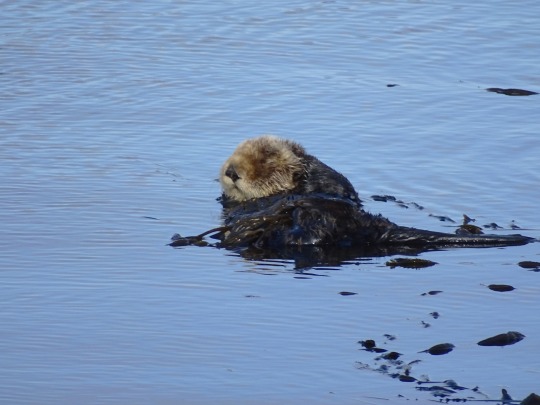
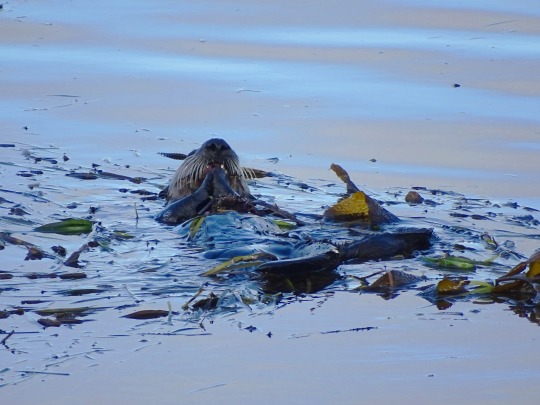
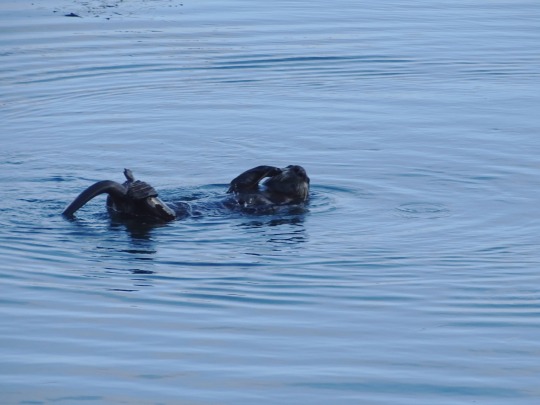
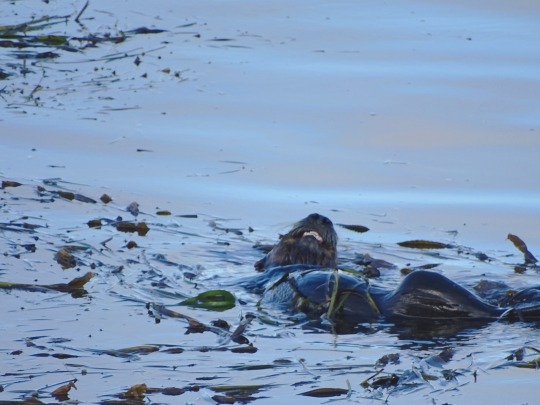
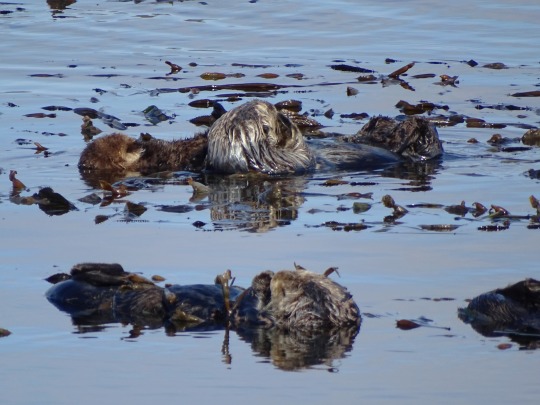
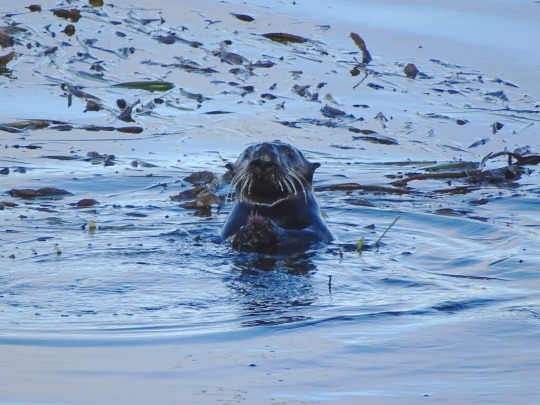
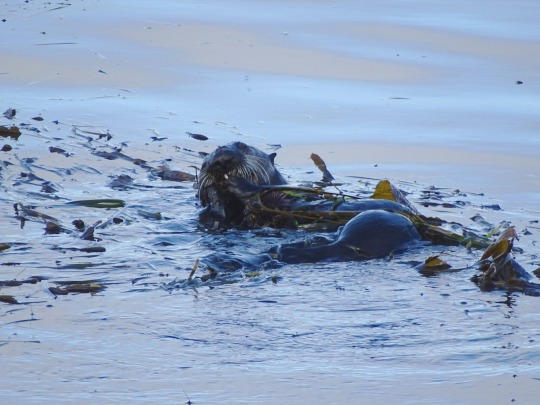
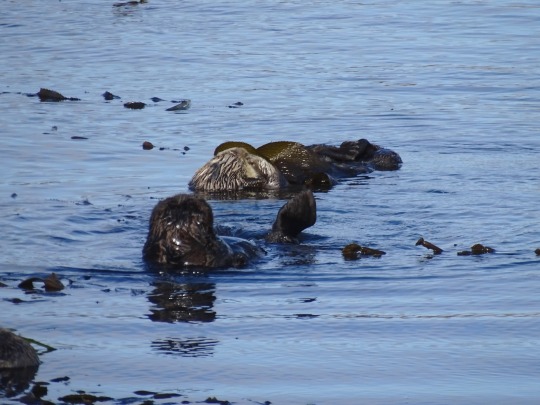
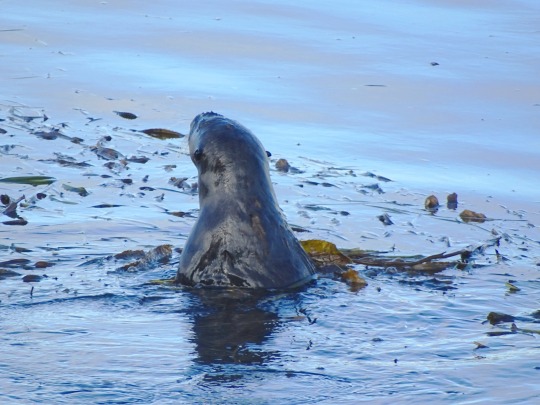
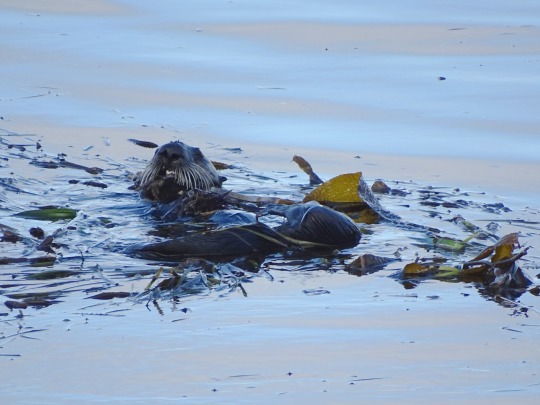
Sea Otter Heaven, Morro Bay (No. 6)
Although the southern sea otter's range has continuously expanded from the remnant population of about 50 individuals in Big Sur since protection in 1911, from 2007 to 2010, the otter population and its range contracted and since 2010 has made little progress. As of spring 2010, the northern boundary had moved from about Tunitas Creek to a point 2 kilometres (1.2 mi) southeast of Pigeon Point, and the southern boundary has moved along the Gaviota Coast from approximately Coal Oil Point to Gaviota State Park. A toxin called microcystin, produced by a type of cyanobacteria (Microcystis), seems to be concentrated in the shellfish the otters eat, poisoning them. Cyanobacteria are found in stagnant water enriched with nitrogen and phosphorus from septic tank and agricultural fertilizer runoff, and may be flushed into the ocean when streamflows are high in the rainy season. A record number of sea otter carcasses were found on California's coastline in 2010, with increased shark attacks an increasing component of the mortality. Great white sharks do not consume relatively fat-poor sea otters but shark-bitten carcasses have increased from 8% in the 1980s to 15% in the 1990s and to 30% in 2010 and 2011.
Source: Wikipedia
#Sea Otter Heaven#California sea otter#Enhydra lutris#Morro Bay#hotel#travel#original photography#vacation#tourist attraction#USA#summer 2022#Califorina#West Coast#San Luis Obispo County#wildlife#animal#seaweed#Morro Rock Ecological Preserve#Pacific Ocean#beach#cityscape#landscape#seascape#kelp#fauna#landmark#marine mammal
10 notes
·
View notes
Photo

Summer Blooms Trouble Great Lakes Estuaries
Dear AGU,
A cocktail of blooms made up of potentially toxin-producing cyanobacteria (Microcystis sp. and Dolichospermum sp.) has now proliferated for over 2 weeks in Muskegon Lake, Michigan – a Great Lakes estuary. Muskegon Lake is one of two dozen drowned river-mouth estuaries in West Michigan that flow into Lake Michigan – a Laurentian Great Lake. Because estuaries occur at the end of their watersheds, they integrate signals of climate change and anthropogenic perturbations from across their water and airsheds.
Water quality in Muskegon Lake has been improving for over a decade (as indicated by a time-series buoy observatory www.gvsu.edu/buoy/), and restoration measures resulting in reduced nutrient inputs from the watershed have been credited for the lake’s recovery. However, recent years (2021, 2022, and now 2024) have witnessed record-breaking blooms due to warmer waters initiating earlier spring onset and later fall overturn compounded by highly variable precipitation/river loading. This summer, there are reports of intense cyanobacterial blooms like those in Muskegon Lake coming from several adjacent coastal estuaries (e.g., Mona Lake in the South, and White Lake in the North) – suggesting this is a region-wide phenomenon and that current restoration efforts are inadequate to address the long-term impacts of ongoing change.
Around the world, rivers, lakes and estuaries serve as vital water sources for humanity, biodiversity and ecosystem function. A warming climate and anthropogenic nutrient pollution coupled with more extreme hydrological cycles could turn these waters green and toxic – compromising ecosystem health, water quality, and overall quality of life.
— Bopi Biddanda, Connor Gabel, Nicole D’Arienzo, Dee Phillips, Kay Dennis, Anna Maki and Tony Weinke, Annis Water Resources Institute, Grand Valley State University, Muskegon, Mich. (www.gvsu.edu/wri/)
4 notes
·
View notes
Text

Lake Erie Blooms
Algal blooms have become a common occurrence on Lake Erie, as much a part of summer at the lake as island-hopping, scenic cruises, and roller coasters. In 2024, a bloom of blue-green algae began forming in the lake’s western basin on June 24—the earliest that a bloom has been identified by NOAA since the agency began tracking them in 2002. It was still present in early September. Bloom season can last into October, with its duration depending on the frequency of wind events that mix lake waters in the fall.
When the OLI-2 (Operational Land Imager-2) on Landsat 9 acquired this image on August 13, the bloom covered approximately 320 square miles (830 square kilometers). Since that date, which was the last time Landsat satellites got a clear look at this part of the lake, the bloom would more than double in area to the season’s likely largest extent of 660 square miles (1,700 square kilometers) on August 22.
Phytoplankton blooms carry implications for the lake ecosystem, human health, the local economy, and even municipal water supplies. The dominant organism in this bloom, a Microcystis cyanobacteria, produces the toxin microcystin, which can cause liver damage, numbness, dizziness, and vomiting. NOAA’s Great Lakes Environmental Research Laboratory measured toxins at concentrations above the recreational limit the week of August 12. The agency noted that toxins can be concentrated in scums, advising that people and their pets stay out of the water near scums.
NOAA and its research partners had forecasted a moderate to above-moderate harmful algal bloom (HAB) in western Lake Erie this summer. Blooms are classified based on their biomass, and a moderate-severity bloom will produce noticeable areas of scum. However, the agency noted, a bloom’s size does not necessarily correlate with its toxicity.
“Nutrient input from the Maumee River is the dominant driver of HAB variability from year to year,” said Brice Grunert, a professor in the department of Biological, Geological, and Environmental Sciences at Cleveland State University. Other factors such as temperature, mixing of the water column, and water movement also influence the extent and duration of blooms, he said. Precipitation can increase the load of nutrients such as nitrogen and phosphorous in runoff to the lake, and warmer, more stratified water can amplify blooms. In 2024, the bloom followed a period of record April rainfall and an intense heatwave, according to news reports.
Satellite imagery plays an important role in helping scientists understand the nuances of phytoplankton blooms, which in turn can aid those charged with monitoring and forecasting the events. Grunert has been working in Lake Erie’s western basin for the past three years to better understand phosphorous cycles within the lake. His team is investigating how satellite imagery, combined with data from sediment sampling and chemical tracers, relates to the amount of algae-producing phosphorous in the water column.
He and other scientists studying aquatic ecosystems will soon have a new tool at their disposal in the form of the OCI (Ocean Color Instrument) aboard NASA’s PACE (Plankton, Aerosol, Cloud, ocean Ecosystem) satellite. This instrument measures waterbodies in hundreds of wavelengths across a spectrum of ultraviolet, visible, and near-infrared light. When fully calibrated, the data will enable scientists to track the distribution of phytoplankton and—for the first time from space—identify which communities of these organisms are present on daily, global scales.
Despite the presence of the word “ocean” in the mission title, PACE also opens new lines of inquiry in the freshwater realm. “There are a lot of interesting questions that can be addressed using PACE imagery in the Great Lakes,” Grunert said. For example, hyperspectral data will be able to reveal phytoplankton pigments that could previously only be estimated with the limited number of spectral bands, he said. And a more detailed perspective of blooms over space and time is expected to help scientists decipher how HABs in Lake Erie develop and why cyanobacterial blooms in Lake Superior are starting to occur. “This unlocks a whole new level of information that can be used to describe the unique and changing ecosystems and biogeochemistry within the Great Lakes,” he said.
Grunert is currently working on a PACE Validation Science Team project, taking field measurements in parallel to observations being collected by PACE’s OCI. These include water-surface color and the optical properties of phytoplankton, sediment, and other substances in the water column.
NASA Earth Observatory image by Wanmei Liang, using Landsat data from the U.S. Geological Survey. Story by Lindsey Doermann.
3 notes
·
View notes
Link
1 note
·
View note
Text
Green Blooms: The Beauty of Climate Change #36
I am hooked on murder mystery. Who has written a thriller on algae?
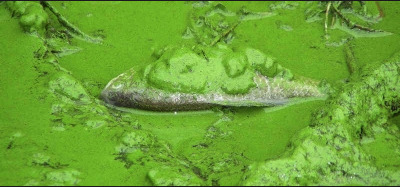
Algae bloom and dead fish, May 2007. Photographer unknown.
The novel Don't Cry, Tai Lake (2012) is a whodunnit set against a backdrop of blue-green algae. The seventh in the series of Inspector Chen novels by Qiu Xiaolong finds him on holiday at Lake Tai, known for its ethereal beauty. He finds the lake covered in green muck caused by polluting factories. His vacation turns to work when the murder of the director of one of those factories is linked to a local environmental group. The Inspector Chen mysteries, written in English, are softboiled detective writing at their best.
In May 2007, the waterworks of Wuxi were choked by green slime and left 2 million people without drinking water for one week. The episode made Wuxi the poster child for the environmental consequences of China's rapid economic growth, as Richard Stone writes.
The government seeded rain to dilute the nasty blue-green algae, and dredged 6000 tons of algae from the lake when the growth reached disastrous proportions.
(Reportedly, rotting algae smells like rotting fish.)
The cyanobacterium, Microcystis aeruginosa, produces toxins that can damage the liver, intestines, and nervous system. Natural rain fall can keep the algae at bay, but the humid heat of Wuxi, in eastern Jiangsu Province, encourages new Microcystis to grow.
The project to remove sources of nitrogen and phosphorus that fuel cyanobacterium is ongoing. The State has relocated hundreds of small chemical and manufacturing plants to close or relocate. They have also situated sewage treatment plants on tributaries of Lake Tai and is dredging the mouths of the tributaries, in order to remove nutrient-rich sediments.
The project is a looking glass for other lakes, according to marine biologist Hans Paerl, an expert in cyanobacteria who joined a team to find ways to rein in the pea-green algae. Lake Tai is China's third largest lake and irrigates food crops and cotton. Honing solutions to the algae in Lake Tai can divert disasters elsewhere. In the United States alone, algal blooms are a serious threat to drinking water and to large freshwater ecosystems. Cyanobacteria cause 2 billion USD of damage a year in losses from water unfit for recreation, drinking, and agriculture. From Late Erie and Lake Okechobee in the United States, to Late Biwa and Kashimagaura in Japan, and Late Victoria in South Africa, microcystis is a threat.
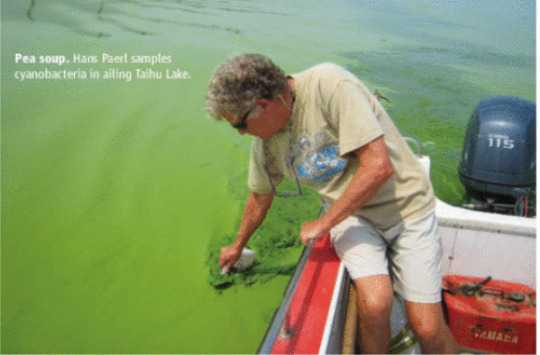
The project of removing nitrogen and restoring the lake may take decades more. The lake water is shallow, and nitrogen from manure that tea farmers use to nurture crops also feeds algae. As much as a quarter of the nitrogen polluting the lake is caused by car exhaust.
The 1970s pop song "Beauty of Late Tai" (Taihu Mei) describes “white sails above the water, green reeds along the water, fish and shrimp below the water.”
August 31, 2023
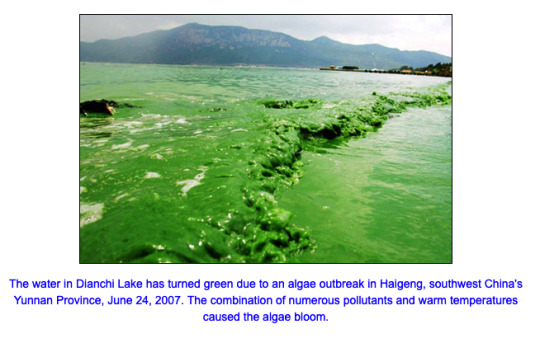
References:
Lucie Guo, "Doing Battle with the Green Monsters of Tai Lake." Science Vol. 307, Issue 5842 (31 August 2007), p. 1156
Pei-yu Catherine Tai and Linda Ellis, "Taihu: Green Wash or Green Clean? " Wilson Center (October 2008)
Richard Stone, "On Lake Taihu, China Moves to Battle Massive Algae Blooms," In Yale Environment 360 (published at the Yale School of the Environment) July 11, 2011
0 notes
Text
Barragem do Maranhão, em Avis, contaminada pela agricultura intensiva
A água da barragem do Maranhão, em Avis, tem uma quantidade perigosa de cianobactérias, que pode chegar a ser fatal para o gado, uma situação que está a preocupar a autarquia, que aponta o dedo ao olival intensivo.
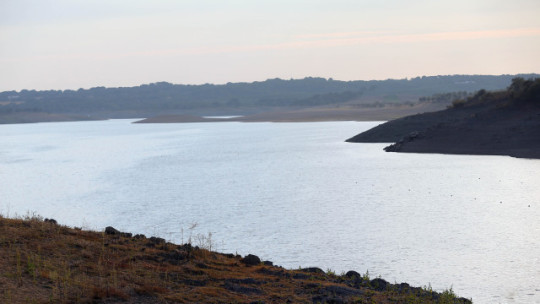
O alerta foi dado à Lusa por Luis Teixeira, proprietário de um empreendimento turístico junto da albufeira, mostrando fotografias e vídeos da água, com manchas azuis claras de um produto pastoso e não identificado. O responsável culpa os olivais intensivos à volta da barragem, constantemente pulverizados com químicos que acabam por ir parar à água.
A vice-presidente da Câmara Municipal de Avis, Inês Fonseca, que tem entre outros o pelouro do turismo, disse hoje à Lusa que o que se está a passar é um problema e que teme que interditem a prática de desportos náuticos na albufeira.
"A agricultura é importante, mas tem de se conseguir que todas as atividades sejam compatíveis", alertou, afirmando que o que está a acontecer coloca em causa os investimentos para a prática de desportos náuticos, como o remo, a canoagem, o triatlo ou a natação em águas abertas.
Inês Fonseca disse que a autarquia já tem falado com os agricultores mas que estes respondem que o problema não é causado por eles, ao que a responsável garante que a Câmara tem feito tudo para eliminar qualquer tipo de descarga para a albufeira e que todas as juntas de freguesia já têm estações de tratamento.
A vice-presidente da câmara de Avis não tem dúvidas de que o problema das cianobactérias surgiu com o aparecimento da agricultura intensiva, basicamente olival, na qual se usa "muitos fertilizantes" que com a chuva acabam na água. A delegação da Agência Portuguesa do Ambiente (APA) confirmou a existência de cianobactérias (também conhecidas como algas azuis).
O Instituto Nacional de Saúde Doutor Ricardo Jorge fez análises a água retirada do meio da albufeira há cerca de duas semanas e o resultado foi o mesmo. Uma bióloga escreveu, num documento a que a Lusa teve acesso, que "a concentração de microcistinas (a toxina de Microcystis aeruginosa) era de tal forma alta que mesmo com a diluição máxima não foi possível dosear".
A especialista alertou que aquela massa de água "é potencialmente perigosa" e que para o gado, que bebe grande quantidade de água, pode ser letal, porque as microcistinas (toxinas produzidas por cianobactérias) são hepatotóxicas (produzem danos no fígado).
Inês Fonseca disse à Lusa que a Câmara também já contactou as autoridades de saúde e que hoje mesmo vão fazer análises à água.
"Estamos a rever o Plano Diretor Municipal (PDM). Tivemos uma reunião com a Direção-Geral de Agricultura, queríamos fazer uma área de salvaguarda dessa agricultura mas disseram-nos que não há forma de impedir a agricultura intensiva", porque a lei não o permite, adiantou.
Basicamente, diz, a Câmara não pode impedir a agricultura intensiva, não sabe na maior parte das vezes quem são os donos.
"As pessoas queixam-se, há um produto branco no chão, que se agarra aos carros, às casas, é toda a gente a queixar-se mas a Câmara não pode fazer nada, não tem respostas para lhes dar. A nossa ideia era no PDM tentar limitar um pouco a agricultura. Tenho muita pena se nos interditarem a prática de desportos náuticos na barragem", que é a ancora do turismo em Avis, afirmou Inês Fonseca.
Pior ficará Luis Teixeira, proprietário de um empreendimento junto da barragem virado para os desportos náuticos. Ele mesmo desportista, começou a remar ali aos 16 anos, participou em nove campeonatos do mundo de remo e em 2009 construiu o hotel, que acolhe os estágios de muitas equipas internacionais de remo.
Luis Teixeira disse à Lusa que a água já tinha estado assim em 2018 e 2020 e acrescenta que a única alteração no local nos últimos anos foi ambiental, com a plantação de olival intensivo à volta da barragem.
O empresário diz que é urgente resolver o problema da barragem do Maranhão e diz que a APA não tem feito nada, nem em anos passados nem neste. Em 2020, exemplificou, foi comunicado o problema em maio e a APA respondeu em outubro. "Nunca foi tomada qualquer providência e a situação só tem vindo a piorar", disse, adiantando que há mau cheiro perto da água.
Luís Teixeira diz mesmo que há falta de vontade para resolver o problema, que se teima em ignorar o que se passa na água no Maranhão.
"Não posso ouvir dizer que somos os líderes da descarbonização quando no terreno a situação é esta", afirmou.
Para José Núncio, presidente da Associação de Regantes do Vale de Sorraia, "a situação não é nova infelizmente e aparece com temperaturas altas e depois desaparece. São as cianobactérias a desenvolver-se e dá aquele aspeto, e depois o vento empurra-as para as margens, no meio da albufeira não se vê".
José Núncio, não nega que o olival possa ser uma das origens do problema mas acrescenta: "são albufeiras antigas, que entram em processo de eutrofização. São 67 anos de lodo e o olival leva pouca água", diz, afirmando esperar que dentro de dois ou três dias a situação normalize.
A associação junta 1.800 agricultores, beneficiários do Maranhão e de Montargil, sendo que esta última barragem não tem problemas assim. Nas declarações à Lusa José Núncio diz que as cianobactérias não têm efeito na rega, que está a começar agora, mas alerta que a barragem não é uma piscina e que tomar banho junto da espuma azul pode ser perigoso para a pele.
Espuma azul, lodo ou produto pastoso branco, diz e repete Inês Fonseca: Venham ver, venham ver e falar com as pessoas.
0 notes
Text
Blue Spirulina
Open main menu
Wikipedia
Search
Phycocyanin
Article Talk
Language
Watch
Edit
Phycocyanin is a pigment-protein complex from the light-harvesting phycobiliprotein family, along with allophycocyanin and phycoerythrin.[1] It is an accessory pigment to chlorophyll. All phycobiliproteins are water-soluble, so they cannot exist within the membrane like carotenoids can. Instead, phycobiliproteins aggregate to form clusters that adhere to the membrane called phycobilisomes. Phycocyanin is a characteristic light blue color, absorbing orange and red light, particularly near 620 nm (depending on which specific type it is), and emits fluorescence at about 650 nm (also depending on which type it is). Allophycocyanin absorbs and emits at longer wavelengths than phycocyanin C or phycocyanin R. Phycocyanins are found in cyanobacteria (also called blue-green algae).[2] Phycobiliproteins have fluorescent properties that are used in immunoassay kits. Phycocyanin is from the Greek phyco meaning “algae” and cyanin is from the English word “cyan", which conventionally means a shade of blue-green (close to "aqua") and is derived from the Greek “kyanos" which means a somewhat different color: "dark blue". The product phycocyanin, produced by Aphanizomenon flos-aquae and Spirulina, is for example used in the food and beverage industry as the natural coloring agent 'Lina Blue' or 'EXBERRY Shade Blue' and is found in sweets and ice cream. In addition, fluorescence detection of phycocyanin pigments in water samples is a useful method to monitor cyanobacteria biomass.[3]
Phycobilisome protein
Phycocyanin assembly.png
Allophycocyanin 12-mer PDB 1all
Identifiers
Symbol
Phycobilisome
Pfam
PF00502
InterPro
IPR001659
SCOP2
1cpc / SCOPe / SUPFAM
Available protein structures:
Pfam
structures / ECOD
PDB
RCSB PDB; PDBe; PDBj
PDBsum
structure summary
Phycocyanobilin
The phycobiliproteins are made of two subunits (alpha and beta) having a protein backbone to which 1-2 linear tetrapyrrole chromophores are covalently bound.
C-phycocyanin is often found in cyanobacteria which thrive around hot springs, as it can be stable up to around 70 °C, with identical spectroscopic (light absorbing) behaviours at 20 and 70 °C. Thermophiles contain slightly different amino acid sequences making it stable under these higher conditions. Molecular weight is around 30,000 Da. Stability of this protein invitro at these temperatures has been shown to be substantially lower. Photo-spectral analysis of the protein after 1 min exposure to 65 °C conditions in a purified state demonstrated a 50% loss of tertiary structure.
Phycocyanin pigment extracted from Microcystis aeruginosa cyanobacteria.
Structure
Spectral characteristics
Ecological relevance
Biosynthesis
Biotechnology
References
Further reading
Last edited 2 months ago by Mykhal
Wikipedia
Content is available under CC BY-SA 3.0 unless otherwise noted.
Privacy policy Terms of Use Desktop
0 notes
Text
přec dovolim si sem přidat nějaký povídání o těch určitejch rodech a skupinách z pohledu naprostýho laika, co se to všecko učí, jen ponáč musí. nebožák má radějc zviřátka, no. třeba se mně to pak bude líp pamatovat? inu, mezi moje oblíbený sinicový zástupce patří třeba chroococcus. chroococus, protože má vtipný chrochtavě znějící jméno, jak kdyby to vymysleli někde v nizozemsku. a jsou docela hezký, hustý. maj buňky zabalený ve slizovym pouzdře. jedinej jejich neduh je, že nemaj bičík. miluju bičíkatý potvůrky!

dalším rodem, kterej si prej mám pamatovat, je snowella. byť opravdu může trochu připomínat třeba nějakou tu sněhovou vločku, svůj název dostala po svém pojmenovateli. plankton.

microcystis je toxická potvora, tvoří nám všem známej vodní květ. plankton.

o merismopedii nám vyučující říkal, že prej vypadá jak tabulka čokolády, mně spíš připomíná ramky. připadá mi hustý, jak jsou vyskládaný. ale zdržujou se spíš u dna, benthos.

oscilla, oscilla, oscilla, oscilla, oscillatóórium! trichální a tedy vláknitá potv��rka. vytvářejí hormogonie, což jsou buňkový vlákna spojený slizem k čemuž dochází jakmile se dostanou do stresu. stačí, aby se třebas jen dostaly do nového prostředí. pletou se mi s jinejma trichálníma sinicema, ale maj kulaťoučký čepečky na koncích!
planktothrix je plankton. a to se mně líbí, dobře se to pamatuje.

arthrospira je známá spíš pod zastaralym názvem spirullina, se kterym se můžeme setkat třeba v obchodech, kde se prodává v pytlíčkách jako zázračnej doplněk stravy. vlní se, je wonky!

microcoleus je půdní sinice. taky má ráda kaluže. narazit na ni můžeme i v poušti, kde na povrchu tvoří jakýsi krusty. je to snad nejvýznamnější autotrofní organismus pouští a jiných suchých oblastí. existuje druh, co se menuje microcoleus vaginatus. nevim proč. a ani to vědět asi nechci?

anabaena! ty se mi celkem líběj. respektive se mně líběj heterocyty, ty divný velký buňky, co se tvářej jako prázdný se dvěma pólama po stranách. maj je vláknitý sinice a sloužej k vychytávání dusíku. ještě jsou u nich k vidění třeba akinety. akineta je nepohyblivá klidová buňka, která vzniká pro přežitý nepříznivých podmínek. má jinej tvar a barvu než normální buňky. no a nakonec má taky aerotopy, ale ty měl třeba i planktthrix. aerotop je vlastně plynovej měchýřek, který sinicim slouží k pohybu ve vodnim sloupci. maj tmavší barvu než jiný buňky, protože kvůli vzduchu, kterým jsou naplněný, maj jinej lom světla. plankton nebo benthos.

aphanizomenon je název, co mi dal zabrat, ale nakonec si ho pamatuju, protože opice a agamemnon. pokud si je člověk přiblíží pod mikroskopem, ale ne moc, připomínaj jakýsi divný vlásky, maj dlouhý vlákna, je jich hodně a jsou blízko u sebe. plankton.

nostoc! nostoc má kůl název. v češtině se jmenuje jednořadka, ale to věčně zapomínám a stejně na aKADEMICKÝ PŮDĚ čeština takřka nikoho nezajímá. v některejch kulturách je jedli, možná pořád jedi. když zmokne, vypadá jak celkem nechutná slizovitá hmota.


a to by byly sinice!
přesunem se k řasám ze skupiny rhodophyta. červený řasy, nebo tak něco. v taxonomii je hroznej bordel, vlastně ani nevim, čemu věřit, čemu ne... v češtině se jim někdy říká taky ruduchy.
batrachospermum. má heterotrichální stélku, tvoří větvená souměrná vlákna. jméno dostalo po tom, že připomíná slizovitý obaly s žabíma vajíčkama.

audouinella je trichální ruducha, co se objevuje třeba v akvárkách.


porphyru snad každej zná, snad každej ji někdy jet,já ji mám dokonce zrovna schovanou ve skříňce vedle sebe. řasa, do který se balí suši, onigiri, ... docela komplikovaná řasa s pletivnou stélkou.

učim se na zápočet ze sinic a řas, kerej píšu za pár hodin, avšak přemejšlim nad tim, že ještě před půl rokem jsem se musela šprtat na zpaměť stovky jmen všemožných i nemožných umělců a že šprtání se vědeckejch názvů organismů vlastně neni vo tolik jinačí. jen mě možná trochu víc baví. protože maj mnohdy roztomilý český ekvivalenty. strašně se bojim, že ten testík budu muset psát znova, protože hrozně prožívám, že sama sebe vnímám jako neznalýho idiota a bojim se taky toho, že mě ostatní vnímaj jako debila, bo jsem na střední chodila na grafku. byť si to tam nejspíš nikdo nepamatuje - proč by, že. a cejtim hroznou potřebu furt někomu - a sobě - dokazovat, že tyvole ačkoli jsem před chvilkou sotva věděla, co je buněčná stěna, tak to nakonec musí jít nějak zvládnout.
10 notes
·
View notes
Text
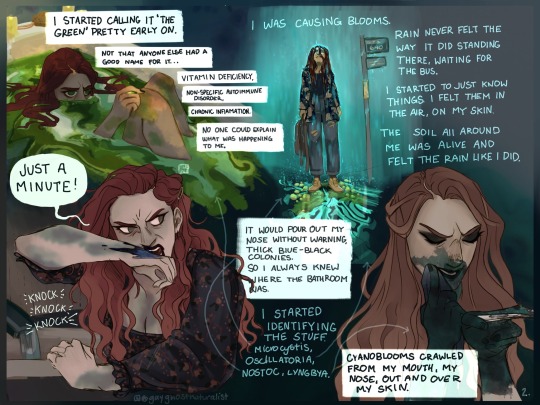
Cyanobacteria are so fucking old and scary and pretty and cute and I love them.
I got the travel grant! Got about a month to get the rest of my housing, food, etc etc covered (Ko-fi in bio if you feel like it).
And my poster. Oh god.
(Also hi and thank you y’all are so sweet)
#poison ivy but she’s an actual botanist#botanical horror#poison ivy art#pamela isley#art#illustration#poison ivy comic#artists on tumblr#character design#concept art#comic#dc#dc comic#dc fanart#nostoc#oscillatoria#lyngbya#cyanobloom#cyanobacteria#microcystis
858 notes
·
View notes
Text
Spirulina

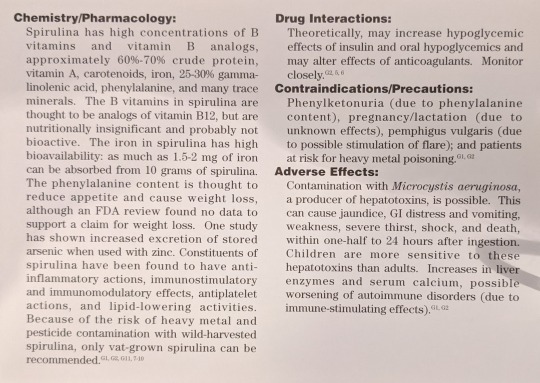
Scientific Names: Microcystis aeruginosa, M. wesenbergii, and other Microcystis species, Spirulina maxima, S. platensis, and other Spirulina species; Anabaena species; Lyngbya wollei; Aphanizomenon flos-aquae Other Common Names: AFA, BGA, blue green algae, cyanobacteria, Klamath blue/green algae Overall Safety: 😐
Therapeutic Efficacy and Considerations:
Bronchial Asthma: 🙁 The one small trial conducted demonstrated no difference from placebo. Spirulina is not recommended for this indication.
Oral Leukoplakia: 😊 Due to spirulina’s high carotenoids (found to have benefit in healing precancerous lesions) content, a trial examined efficacy of S. fusiformis for treatment of leukopenia and demonstrated complete regression of homogenous lesions in 57% of patients. Because this precancerous condition requires close monitoring and treatment, it is recommended that spirulina not be used as monotherapy, but only as an adjunct to conventional treatments under a healthcare provider’s supervision. Dose: no more than 1 gm/day.
Kidney Disease-Associated Hyperlipidemia: 😐 Although preliminary evidence demonstrates that spirulina may have effects to lower cholesterol in patients with patients with kidney disease, at this time evidence is not sufficient to recommend use for this indication. Dose: 1-5 gm per day.
Hyperlipidemia and Hyperglycemia Associated with Type II Diabetes: 😐 Small, preliminary trials demonstrate that spirulina may have benefit in lowering cholesterol and fasting blood sugar. At this time, evidence is not sufficient to recommend use. Dose: no more than 1 gm BID.
Note: In general, although in vitro and preliminary tests have found many beneficial activities, spirulina can, with the possible exception of prevention of leukopenia progression, be considered to be a very expensive source of trace minerals. Patients who wish to take spirulina because of its gamma-linolenic acid (GLA) content, should be directed toward less expensive sources, such as evening primrose oil.
Chemistry/Pharmacology: Spirulina has high concentrations of B vitamins and vitamin B analogs, approximately 60-70% crude protein, vitamin A, carotenoids, iron, 25-30% gamma-linolenic acid, phenylalanine, and many trace minerals. The B vitamins in spirulina are thought to be analogs of vitamin B12, but are nutritionally insignificant and probably not bioactive. The iron in spirulina has high bioavailability: as much as 1.5-2 mg of iron can be absorbed from 10 grams of spirulina. The phenylalanine content is thought to reduce appetite and cause weight loss, although an FDA review found no data to support a claim for weight loss. One study has shown increased excretion of stored arsenic when used with zinc. Constituents of spirulina have been found to have anti-inflammatory actions, immunostimulatory and immunomodulatory effects, antiplatelet actions, and lipid-lowering activities. Because of the risk of heavy metal and pesticide contamination with wild-harvested spirulina, only vat-grown spirulina can be recommended.
Drug Interactions: Theoretically, may increase hypoglycemic effects of insulin and oral hypoglycemics and may alter effects of anticoagulants. Monitor closely.
Contraindications/Precautions: Phenylketonuria (due to phenylalanine content), pregnancy/lactation (due to unknown effects), pemphigus vulgaris (due to possible stimulation of flare); and patients at risk of heavy metal poisoning.
Adverse Effects: Contamination with Microcystis aeruginosa, a producer of hepatotoxins, is possible. This can cause jaundice, GI distress and vomiting, weakness, severe thirst, shock, and death, within one-half-24 hours after ingestion. Children are more sensitive to these hepatotoxins than adults. Increases in lever enzymes and serum calcium, possible worsening of autoimmune disorders (due to immune-stimulating effects).
#sigler dietary supplement drug cards#2nd edition#spirulina#microcystis aeruginosa#microcystis wesenbergii#spirulina maxima#spirulina platensis#anabaena species#lynbya wollei#aphanizomenon flos-aquae#afa#bga#blue green algea#cyanobacteria#klamath blue/green algea#drug facts
2 notes
·
View notes
Text
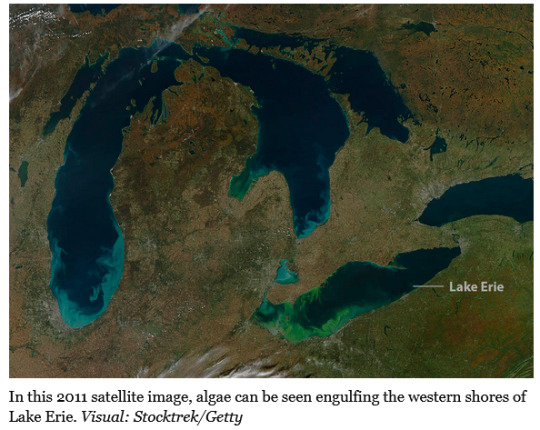

On Saturday, August 2, 2014, the water supply for the city of Toledo, Ohio, was poisoned. Officials issued an unequivocal order to the half million residents connected to the municipal intake: Don’t drink, cook, or brush your teeth with the water. [...] Stores ran out of bottled water, leaving residents to queue up at local fire stations [...]. The culprit was a bright green plume of Microcystis, a cyanobacterium that thrives in warm water [...]. In spring, rains wash a pulse of nutrients off the surrounding region’s fertilized farms and send it down the Maumee and Sandusky Rivers and into western Lake Erie. [...] Tests showed that the city’s water contained dangerous levels of microcystin, a liver toxin produced by the bloom.
The source of the problem stretches for thousands of square miles across northwestern Ohio and eastern Indiana. The rich earth [...] in the region produces hundreds of millions of dollars’ worth of soybeans and corn, as well as wheat, vegetables, pork, and poultry. The landscape is a vast, flat expanse of tidy fields and modest farmhouses crisscrossed with county roads — but it wasn’t always this way.
Centuries ago, this part of the Midwest was a wild expanse of wet forest and marsh stretching across a million acres, and early settlers who slogged through the muck and mosquitoes called the place the Great Black Swamp. [...] On an 1808 map, the swamp, which covered most of northwestern Ohio, was designated as “land not worth a farthing.”
But settlers came anyway, felling the giant sycamores and oaks to create roads, and digging miles of drainage trenches to slowly bleed the water away from the muck. [...]
They [”the wetlands”] are considered a menace, a threat, a thing to be overcome. These attitudes are enshrined in state law, which makes impossible any action, including wetland restoration, that slows the flow of runoff through those miles of constructed drainage ditches [...].
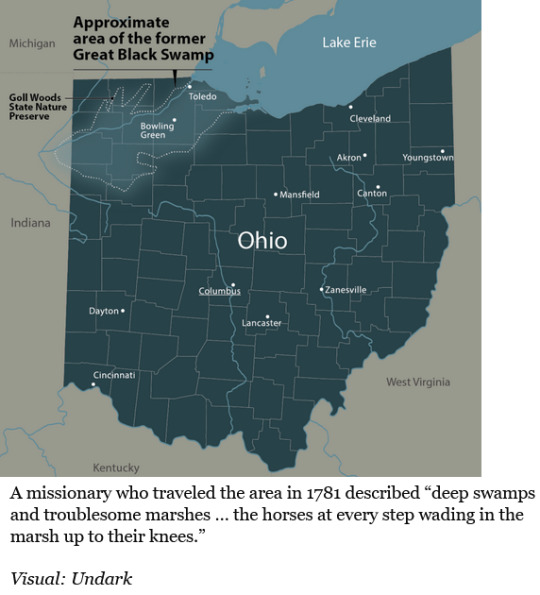
[S]oldiers recorded the striking bounty of the Black Swamp and Lake Erie’s southwestern shore. On an April morning in 1813, two hungry soldiers stationed at Fort Meigs, near present-day Toledo, walked down to the Maumee River. The clear waters swarmed with perch, muskellunge, sturgeon, and catfish. Plunging spears into the water at random, they caught 67 fish in 30 minutes, often killing two or three with a single stroke. Every river mouth west of the Sandusky held dense beds of wild rice, where waterfowl settled to feed, then rose in flocks that darkened the sky. The rice stalks stood taller than a man’s head: to feed, ducks grabbed the stems with their feet and tugged the seed heads down to the water. [...]
In 1859, the Ohio General Assembly passed a law authorizing county commissioners to construct drainage ditches. Farmers benefiting from ditch construction shared the cost. The other Midwestern states also enacted laws authorizing drainage districts, enabling the construction of vast networks of ditches that drained great swathes of land — a mission that required investment and coordination, and could not have been accomplished by individual landowners.
Through the work of drainage districts, the Corn Belt states would lose more than 95 percent of their native wetlands. [...]
Some enterprising soul tested the abundant clay that lay a foot or two beneath the soil of the Black Swamp, and found that it made excellent tiles.
By 1880, more than 50 tile factories operated in northwest Ohio, and the Black Swamp was dismembered and used to feed an accelerating and diversifying cycle of human industry.
The great wetland trees — ash, elm, oak, sycamore — were felled and used to build houses, make furniture, and power the railroads that sprouted up across Ohio. In the 1860s, Ohio’s railways consumed one million cords of wood each year as fuel, and an unknown quantity for ties. The discovery of underdrainage created a growing demand for tile. All this drove an orgy of forest clearing and land draining which in the course of five decades, from 1870 to 1920, completely erased the Black Swamp. A wilderness went up in the smoke from railroad engines, and flowed in drainage ditches down to the Maumee and Sandusky, which began to run murky and lost their once-bountiful populations of fish.
Among the descendants of the settlers who conquered the Black Swamp, drainage is viewed as sacred, while wetland restoration borders on the profane. In terms of water quality, a prime place to create wetlands would be where they intercept the flow of polluted water in farm ditches. That could cause water to back up and flood the fields, however, and it is forbidden under Ohio’s ditch laws, which have changed little since 1859.
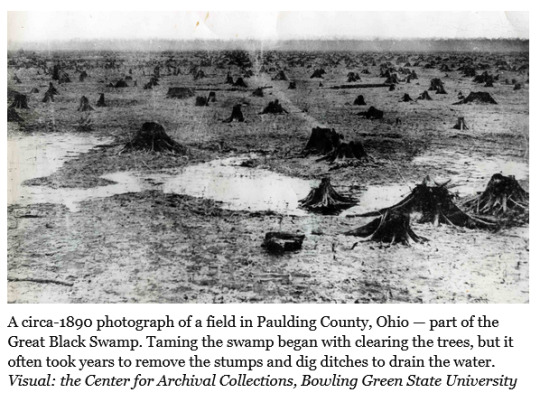
-------
All text, images, and captions published by: Sharon Levy. “Learning to Love the Great Black Swamp.” Undark. 31 March 2017. [Bold emphasis and some paragraph breaks added by me.]
2K notes
·
View notes
Text




some micro pictures from my botany class :)
2 - colony of microcystis
3 - a tick in algae
(sorry for my bad english 🥴)
#biology#microscope slide#microscope#studyblr#study#slide#microscopic#scientific#microbiology#micro#botany#microlife#algae
225 notes
·
View notes
Photo

Like Lawn on a Lake: Nuisance Blooms Plague a Great Lakes Estuary
Dear Eos,
Like a floating lawn on water, dense surface blooms of cyanobacteria (Microcystis sp.) persist unusually late into October 2021 in Muskegon Lake, Michigan. Microcystis, the most common genus of bloom-forming cyanobacteria afflicting freshwater ecosystems world-wide, produces unsightly surface scums as well as a potent liver toxin, microcystin.
Muskegon Lake is an urbanized drowned river-mouth estuary with a highly productive fishery that connects Michigan’s 2nd largest watershed to Lake Michigan – a Laurentian Great Lake. Water quality in Muskegon Lake has been improving for over a decade, as indicated by increasing water clarity and decreasing cyanobacterial bloom abundance (recorded by a time-series buoy observatory, www.gvsu.edu/buoy/) – in response to concerted restoration measures resulting in reduced nutrient runoff from the watershed. However, 2021 has seen a super-abundance of blooms due to an extended warm period characterized by an earlier spring onset and later fall overturn. Measurements of microcystin in nearshore areas taken by the Michigan Department of Environment, Great Lakes and Energy have revealed levels exceeding WHO and EPA guidelines for drinking and recreational water use several-fold, implying a clear turnaround of recent trends. Indeed, a recent NOAA hyperspectral overflight has recorded cyanobacterial blooms covering several coastal lakes – including Muskegon Lake.
Increasing climate warming could disrupt numerous ongoing ecosystem restoration efforts around the world, turning lakes green and toxic – much like the lawns that increasingly crowd their shorelines.
— Bopi Biddanda, Ian Stone, Nate Dugener, Tony Weinke, Rick Rediske, Annis Water Resources Institute, Grand Valley State U, Muskegon, Mich. (www.gvsu.edu/wri/); Jasmine Mancuso, Oakland University, Mich. (www.oakland.edu/); Aaron Parker, Michigan Department of Great Lakes and Energy, MIch. (www.michigan.gov/egle/); Lauren Marshall, Andrea VanderWoude and Steven Ruberg, National Oceanic and Atmospheric Administration, Mich. (www.glerl.noaa.gov/)
4 notes
·
View notes
Text

Lake Erie Blooms
Algal blooms have become a common occurrence on Lake Erie, as much a part of summer at the lake as island-hopping, scenic cruises, and roller coasters. In 2024, a bloom of blue-green algae began forming in the lake’s western basin on June 24—the earliest that a bloom has been identified by NOAA since the agency began tracking them in 2002. It was still present in early September. Bloom season can last into October, with its duration depending on the frequency of wind events that mix lake waters in the fall.
When the OLI-2 (Operational Land Imager-2) on Landsat 9 acquired this image on August 13, the bloom covered approximately 320 square miles (830 square kilometers). Since that date, which was the last time Landsat satellites got a clear look at this part of the lake, the bloom would more than double in area to the season’s likely largest extent of 660 square miles (1,700 square kilometers) on August 22.
Phytoplankton blooms carry implications for the lake ecosystem, human health, the local economy, and even municipal water supplies. The dominant organism in this bloom, a Microcystis cyanobacteria, produces the toxin microcystin, which can cause liver damage, numbness, dizziness, and vomiting. NOAA’s Great Lakes Environmental Research Laboratory measured toxins at concentrations above the recreational limit the week of August 12. The agency noted that toxins can be concentrated in scums, advising that people and their pets stay out of the water near scums.
NOAA and its research partners had forecasted a moderate to above-moderate harmful algal bloom (HAB) in western Lake Erie this summer. Blooms are classified based on their biomass, and a moderate-severity bloom will produce noticeable areas of scum. However, the agency noted, a bloom’s size does not necessarily correlate with its toxicity.
“Nutrient input from the Maumee River is the dominant driver of HAB variability from year to year,” said Brice Grunert, a professor in the department of Biological, Geological, and Environmental Sciences at Cleveland State University. Other factors such as temperature, mixing of the water column, and water movement also influence the extent and duration of blooms, he said. Precipitation can increase the load of nutrients such as nitrogen and phosphorous in runoff to the lake, and warmer, more stratified water can amplify blooms. In 2024, the bloom followed a period of record April rainfall and an intense heatwave, according to news reports.
Satellite imagery plays an important role in helping scientists understand the nuances of phytoplankton blooms, which in turn can aid those charged with monitoring and forecasting the events. Grunert has been working in Lake Erie’s western basin for the past three years to better understand phosphorous cycles within the lake. His team is investigating how satellite imagery, combined with data from sediment sampling and chemical tracers, relates to the amount of algae-producing phosphorous in the water column.
He and other scientists studying aquatic ecosystems will soon have a new tool at their disposal in the form of the OCI (Ocean Color Instrument) aboard NASA’s PACE (Plankton, Aerosol, Cloud, ocean Ecosystem) satellite. This instrument measures waterbodies in hundreds of wavelengths across a spectrum of ultraviolet, visible, and near-infrared light. When fully calibrated, the data will enable scientists to track the distribution of phytoplankton and—for the first time from space—identify which communities of these organisms are present on daily, global scales.
Despite the presence of the word “ocean” in the mission title, PACE also opens new lines of inquiry in the freshwater realm. “There are a lot of interesting questions that can be addressed using PACE imagery in the Great Lakes,” Grunert said. For example, hyperspectral data will be able to reveal phytoplankton pigments that could previously only be estimated with the limited number of spectral bands, he said. And a more detailed perspective of blooms over space and time is expected to help scientists decipher how HABs in Lake Erie develop and why cyanobacterial blooms in Lake Superior are starting to occur. “This unlocks a whole new level of information that can be used to describe the unique and changing ecosystems and biogeochemistry within the Great Lakes,” he said.
Grunert is currently working on a PACE Validation Science Team project, taking field measurements in parallel to observations being collected by PACE’s OCI. These include water-surface color and the optical properties of phytoplankton, sediment, and other substances in the water column.
NASA Earth Observatory image by Wanmei Liang, using Landsat data from the U.S. Geological Survey. Story by Lindsey Doermann.
2 notes
·
View notes
Link
1 note
·
View note
Text
Face masks protect against aerosolized toxins from algal blooms, study finds
https://sciencespies.com/environment/face-masks-protect-against-aerosolized-toxins-from-algal-blooms-study-finds/
Face masks protect against aerosolized toxins from algal blooms, study finds
Intense blooms of toxic algae are becoming common occurrences along the coast of Florida and elsewhere. Results from a new study led by University of Miami (UM) scientists found that wearing the face mask everyone has become accustomed to during the COVID-19 pandemic may help protect against these airborne toxins too.
The UM Rosenstiel School of Marine and Atmospheric Science researchers designed an experiment to understand how effective commonly available air conditioner filters and face masks are at filtrating out the toxins emitted during harmful algal bloom events.
“We found that face masks and air conditioner filters with high filter performance ratings can reduce the risk of exposure by filtering out small, toxin-containing particles,” said the study’s lead author Cassandra Gaston, an assistant professor of atmospheric sciences at the UM Rosenstiel School.
“These filter materials can also be effective at filtering out other kinds of small particles as well,” said Haley Royer, a co-first author of the study and Ph.D. student at the UM Rosenstiel School’s Department of Atmospheric Sciences. “As we all know by now, face masks are essential in preventing the transmission of COVID-19 from person to person.”
Harmful algal blooms, often referred to as red tides and blue-green algae, are exacerbated by nutrient-rich runoff from agriculture and industrial waste that end up in waterways. Noxious particles enter the air mostly from the breaking of waves, resulting in airborne toxins that cause serious health problems to humans and marine life. Airborne toxins can also affect indoor air quality particularly for businesses and homes near contaminated waterways.
To conduct the experiment, the researchers created a bubbling device to produce airborne toxin-containing particles in the lab by bubbling air into the liquid containing cultures of a toxic-producing blue-green algae, Microcystis aeruginosa. Cutouts of three types of face masks and six types of AC filters purchased from home improvement stores were placed in-line with generated particles to determine how well the masks and filters blocked particles of different sizes. The researchers used N95, disposable surgical mask and medical-grade, odor-filtering carbon fiber masks. For AC filters, the researchers used filters for window units and central air conditioning units with different filter performance ratings.
They found that AC filters filtered out 20-90% of the airborne particles with particle filtration increasing with increasing filter performance rating. Face masks filtered out over 90% of toxin-containing particles. The findings suggest that low-cost, commercially available face masks and AC filters with high filtration efficiency ratings can help avoid both indoor and outdoor exposure to harmful algal bloom toxins in the air.
Harmful algal blooms are expected to become more prevalent worldwide due to climate change and increased nutrient runoff from a growing human population.
According to the researchers, the study also has relevance for the transmission of SARS-CoV-2, the virus responsible for the current COVID-19 pandemic. The virus has an average size of 60-140 nanometers, which is within the size of particles investigated in this study.
The study, titled “Filtration Efficiency of Air Conditioner Filters and Face Masks to Limit Exposure to Aerosolized Algal Toxins,” was accepted for publication on April 20, 2021 in the journal Aerosol and Air Quality Research.
The study’s authors include: Cassandra Gaston, Haley Royer, Raymond Leibensperger III, Daniela Maizel, Kaycie Lanpher, Helena Solo-Gabriele, Larry Brand, R. Grace Zhai, Alberto Caban-Martinez and Kimberly Popendorf from the University of Miami.
Funding for the study was provided by the UM Laboratory of Integrated Knowledge (U-LINK) and Florida Department of Health (DOH) project “Diversity and Innovation in Screening and Prevention of Exposure over the Long-term (DISPEL) to HABs.” DOH funding supported preparation of visual and video materials for communicating strategies to the public for reducing HAB exposures.
#Environment
2 notes
·
View notes